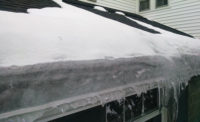Preventing Dangerous Ice Dams

The conditions that allow ice dams to form occur every winter, and to prevent damage from recurring homeowners must be proactive. When temperatures drop into single digits, big and sparkly icicles may form on the edge of a roof. They sure look pretty, but are actually a warning sign of improper roof insulation and/or roof ventilation, along with possibly air leaks in the attic.
When heat rises into a home’s attic, most of the roof is warmed. However, that warmth doesn’t make it to the eaves. As snow on the roof melts, the water freezes on those cold eaves and creates an ice dam. Because the melted water can't drain into the gutter, it backs up under the shingles and will eventually enter the house. The resulting damage can be extensive and quite costly to repair.
Protect The Deck
Underlayment, the unseen component of a roof system, goes over the roof deck and under the roof covering material. It provides protection needed to maintain the integrity of a roof and installing cheap underlayment could lead to roof failure in the future. For the long run it will be much less expensive to install a new roof with an underlayment that will prevent ice dams.
There are three primary forms of underlayment; asphalt-saturated felt, rubberized asphalt, and synthetic. While all are capable products, synthetic underlayment has become a more popular choice. This product provides excellent protection in problem roof areas where water can collect or drainage is slow. More importantly it meets the ASTM D1970 standard for ice dam preventive underlayment.
Another effective ice dam prevention product is roof underlayment that has a modified self-adhesive membrane. This type of roofing underlayment provides a secondary layer of waterproofing protection that helps prevent damage caused by ice dams and wind-blown rain.
A Roof Must Breathe
Some homeowners try to prevent ice dam formation by installing electric radiant heat systems in their home’s roof gutters. This can work, but the initial price of the system and the added monthly energy costs tend to make that method quite an expensive choice. A properly insulated and ventilated roof is the most practical way to prevent ice dams.
A proper ventilation system extends the life of a roof because it minimizes the temperature differential between the attic and the outside air. An inefficient roof ventilation system can raise energy costs, damage roof system components, and cause ice dams to form. An effective ventilation system will control attic moisture in cold months and exhaust hot air in the summer. Efficient eave vents are engineered to keep the entire roof system balanced and promote the correct flow of air. This greatly helps to prevent ice dams.
There are also interior conditions that can disrupt attic insulation and ventilation. Any and all openings leading to the attic floor must be sealed. That includes ceiling light fixtures, attic access doors, electrical wiring, plumbing pipes, exhaust fans, and chimney chases. If these points are not adequately sealed, warm moist air will travel from lower levels to the attic that could cause severe damage as it condenses.
Hire A Professional
The first step in the fight against ice dams is to contact a professional roofing contractor, preferably before the snow begins. Your contractor should perform an inspection to see if the roof’s ventilation system is functioning, as it should. That inspection should also examine the condition of the roof covering and underlayment to see if these components are in the condition needed to prevent ice dam formation.
Before the cold winter months arrive, hire a roofing contractor qualified in detailed roof inspections. This will give you the time to have your roof prepared to battle ice dam formations.
Looking for a reprint of this article?
From high-res PDFs to custom plaques, order your copy today!




